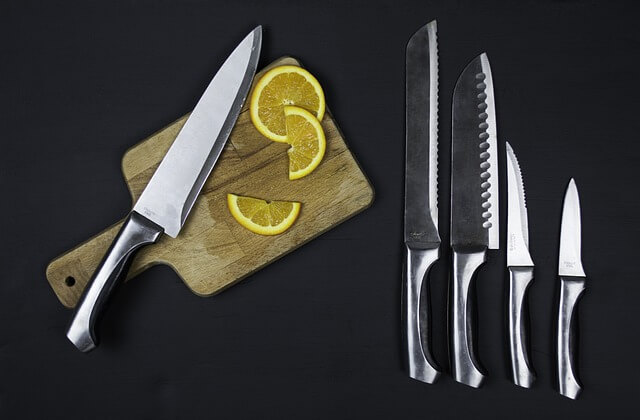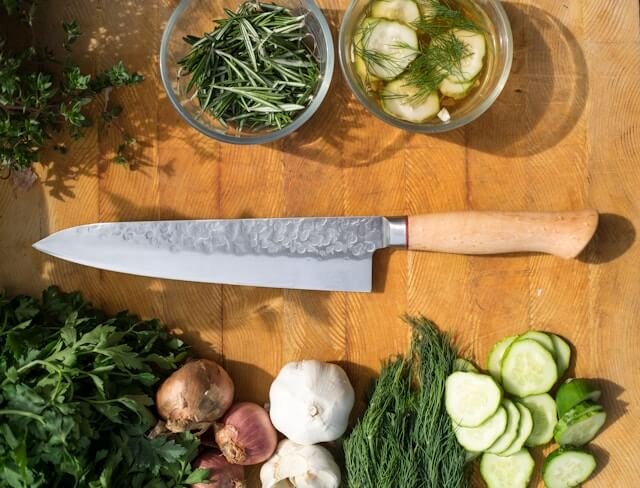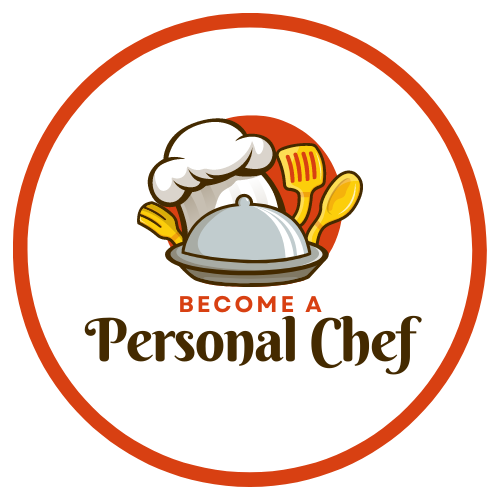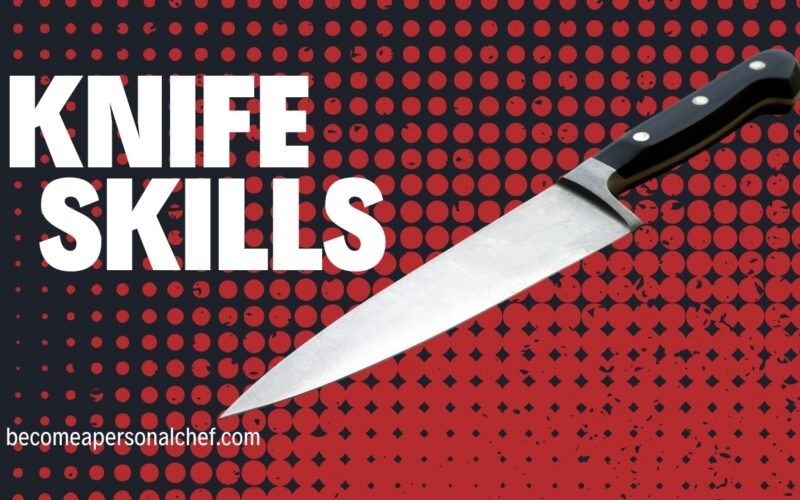Table of Contents
ToggleMastering Knife Skills
In the bustling world of gastronomy, the symphony of sizzling pans and aromatic vinegar notes often drowns out the unsung hero of the culinary craft — the knife. Whether it’s precision cuts on a Mise en place or the deft carving of a succulent steak, mastering knife skills is not just about kitchen finesse; it’s a foundational art form for any cook setting course for culinary excellence.
Mastering Knife Skills For personal chefs and culinary enthusiasts alike, a thorough understanding of the tools at hand, the art of honing and the practice of technique can transform the cooking experience from mundane to magnificent. This guide will take you through the finer points of knife mastery, from understanding and handling your blades to teaching and transferring this invaluable savoir-faire to your clients.
Wondering what tools a personal chef might need? I’ve written an extensive article for you – A Comprehensive List Of Must-Have Tools and Essential Items for the Personal Chef
Understanding Your Tools
In the tapestry of culinary crafts, knives are the warp, and all other tools play the weft. A personal chef’s knife bag is akin to an artist’s palette; it contains a specific tool for every stroke. GLOBAL brand knives, distinguished by their Japanese heritage and razor-sharp edges, are often a favorite for their precision and lightweight maneuverability.
However, no matter what brand or style you prefer, understanding your tools is essential for any personal chef.
First and foremost, it’s important to have a sharp knife. A dull blade not only makes slicing and chopping more difficult but also increases the risk of injury. Invest in a good sharpening stone or take your knives to a professional for regular maintenance.
It’s also crucial to choose the right knife for the task at hand. Different types of knives are designed for specific purposes; a chef’s knife is great for general cutting and mincing, while a paring knife is better suited for detailed work such as peeling and trimming.

Choosing the Right Tool
The selection of a knife should be based on task but also personal comfort. When choosing a knife, pick it up.
How does it feel in your hand? Does the weight and shape align with your cooking habits? The best knife is one that feels like an extension of your arm and gives you the control required for any cut. Different tasks require different knives, so it’s important to have a variety of options in your kitchen.
Chef’s Knife
The chef’s knife is the most versatile tool in the kitchen. It can handle everything from chopping vegetables to slicing meat and even mincing herbs. The blade is usually between 6-14 inches long and has a curved edge for rocking back and forth while cutting. This motion allows for efficient and precise cuts, making it a go-to choice for many chefs.
Santoku Knife
Similar to a chef’s knife, the Santoku knife is also well-suited for chopping vegetables and slicing meat. However, it has a shorter blade with less curve, making it ideal for delicate tasks like finely dicing onions or mincing garlic. Its straight edge also allows for a cleaner cut when working with ingredients like sushi or sashimi.
Paring Knife
A paring knife is perfect for more intricate tasks, such as peeling and coring fruits and vegetables or deveining shrimp. It has a smaller blade, usually around 3-4 inches long, making it easy to maneuver and control. This knife is essential for precise work and can even be used to hull strawberries or remove the seeds from peppers.
Bread Knife
As the name suggests, this knife is designed specifically for cutting bread. Unlike other knives that have sharp pointed tips, a bread knife has a serrated edge that easily slices through crusty loaves without squishing the soft interior. It’s also useful for cutting through other foods with a hard exterior and soft interior, such as tomatoes or cakes.

Sharpening Techniques
A dull knife is not just a nuisance; it’s dangerous. It’s essential to nurture an ongoing relationship with whetstones, sharpening rods, or even electric sharpeners to maintain that fine, keen edge that is the hallmark of precision cutting.
Importance of Knife Maintenance
Regular sharpening is not an indulgence but a necessary maintenance task. Encourage a regimen of weekly honing and periodic sharpening to your routine, and you’ll notice a significant enhancement in your knife’s performance and, by extension, your ease and efficiency in the kitchen.

Methods for Sharpening Knives
There are various methods for bringing knives back to life. Whetstones offer a hands-on experience that connects you intimately with each blade’s profile. Sharpening rods are another popular choice, offering quick edge alignments. For those who desire swiftness and convenience, electric sharpeners can be an efficient solution.
Knife Skills Techniques
The true art of knife skills lies in technique. There’s a difference between hacking and slicing, and that difference is what separates a novice from a master.
Mastering Knife Skills – A sharp knife is essential, but it’s not the only factor in achieving precise and efficient cuts. Knowing how to handle your knife properly and executing different techniques can elevate your cooking game to a whole new level.
First things first, let’s talk about the importance of a sharp knife. Dull knives not only make cutting more difficult, but they also increase the risk of injury. A dull blade requires more force to cut through food, which can lead to slips and accidents. On the other hand, a sharp knife allows for smoother and cleaner cuts with minimal effort.

Basic Handling and Safety
Always curl your fingers back when cutting and use a ‘pinch grip’ with your thumb and forefinger close to the blade. Mastering Knife Skills – Keep a clean, dry workstation to prevent slippage accidents. Use a sharp knife to prevent excessive force and slipping when cutting. Always cut away from your body and keep your non-cutting hand in a claw shape to protect your fingers.
When handling food, it is important to practice basic safety measures to avoid accidents or contamination. This includes properly using and handling knives, keeping a clean workstation, and being aware of potential hazards.

Precision Cutting
Mastering precision cuts like julienne and brunoise might take practice, but they are as rewarding as they are satisfying. Perfectly uniform pieces cook evenly and display professional prowess.
Precision cutting is a fundamental skill in the culinary world that sets apart amateur cooks from professional chefs. It involves using precise and consistent cuts to create uniform pieces of ingredients, resulting in not only aesthetically pleasing dishes but also evenly cooked food.
Mastering Knife Skills – The most common types of precision cuts include julienne, brunoise, and chiffonade. Julienne involves cutting long and thin strips of ingredients, usually vegetables or fruits. Brunoise consists of small cubes with dimensions around 1/8 inch on each side. Chiffonade is thinly shredded herbs or leafy greens.
Mastering these cuts requires proper technique and tools such as sharp knives and mandolines. It also takes practice to achieve consistent results every time. Professional chefs spend years perfecting their cutting skills, but home cooks can also learn and benefit from incorporating precision cuts into their cooking.
Advanced Cuts and Slicing Styles
Elevate your skills with advanced cuts such as chiffonade for herbs, or the oblique cut for root vegetables. These techniques not only add aesthetic appeal but can fundamentally alter the taste and texture of your dish.

Caring for Your Knives
Investing in a set of quality knives is only the beginning; ensuring their longevity requires proper care and respect.
Storage and Organization
The way you store your knives is as important as how you use them. A magnetic strip or a knife block keeps blades safely stored and readily accessible, preventing nicks that can dull the edge.
Cleaning and Drying Techniques
Simple soap and water are your friends when cleaning knives. Always dry them immediately and thoroughly to prevent rust and discoloration.
Common Knife Mistakes
Understand the mistakes that can harm your knives, such as leaving them in the sink, carelessly chopping on hard surfaces like marble or glass, or placing them in the dishwasher.
Favorite Knife Spotlight
Personal chefs often have an icon in their collection, a knife they reach for instinctively. My personal favorite is the GLOBAL G-2, a classic chef’s knife that feels like an extension of my hand. The weight distribution, the sharpness, and the fine balance allow for effortless chopping, slicing, and dicing.

Teaching Knife Skills
If you are a personal chef, part of your service is not just creating exquisite meals but also educating your clients.
Customizing Lessons
Every client comes with a different set of culinary abilities. Tailor your knife skill lessons to their needs, be it the basics for newbies or advanced techniques for the adventurous.
Importance of Patience in Teaching
Patience is a virtue in the kitchen. Teach with a gentle, guiding hand; the confidence instilled in your clients will resonate in the dishes they create.
Demonstration and Practice
Demonstrate the correct technique, but also allow plenty of supervised practice. Repetition is the mother of skill, and watching your clients’ dexterity improve can be one of the most rewarding aspects of your profession.

Mastering Knife Skills
Sharpening your knife skills is a never-ending pursuit, a compelling narrative in the story of your culinary evolution. Practice doesn’t make perfect, but it does make permanent. The more you engage with your knives, the more they will respond to your command, and the circle of control and creativity will expand within your kitchen.
For personal chefs, the ability to wield a knife with the grace of a conductor leading an orchestra is a skill unmatched. Share this philosophy with your clients, and not only will their gastronomic horizons broaden, but their appreciation for the culinary arts will deepen.
Mastering Knife Skills – Take these insights, put them to practice, and soon you’ll find that the simple act of slicing an onion can be an exercise in meditative mastery. Your knife—an extension of creativity, a part of you, crafting edible delight with every perfect cut.
Here are some of my favorite tools for providing my personal chef service
As an experienced personal chef, I’ve found that the secret to creating mouthwatering dishes goes beyond just having a passion for food. It’s also about using the right kitchen tools. Today, I’m going to share with you my must-have kitchen items that help me bring my culinary creations to life.
1. Chef’s Knife
The first item on my list is a high-quality chef’s knife. It’s the most versatile tool in my kitchen, perfect for chopping, slicing, and dicing. My preference is for a Global Chef’s Knife, known for the edge and the way they are balanced.
2. Cast Iron Skillet
Next up is a good old cast-iron skillet. From searing steaks to baking cornbread, this pan does it all. I love the Lodge Cast Iron Skillet, which retains heat beautifully and adds a nice crust to anything you cook.
3. Stainless Steel Pots and Pans
A set of stainless steel pots and pans is essential for a variety of cooking techniques. They’re great for simmering, boiling, and sautéing. All-Clad’s Stainless Steel Cookware Set is my go-to choice for its exceptional performance and durability.
4. Immersion Blender
An immersion blender makes pureeing soups, making smoothies, and blending sauces a breeze. I suggest the Braun Multiquick Hand Blender, which is powerful, easy-to-clean, and highly versatile.
5. Digital Thermometer
To ensure perfectly cooked meats every time, a digital thermometer is a must. The ThermoPro TP19 Waterproof Digital Meat Thermometer provides speedy and accurate readings, ensuring your roast chicken or prime rib is cooked to perfection.
6. Silicone Spatula
A silicone spatula is a chef’s best friend for its versatility. It’s heat-resistant, non-stick, and perfect for everything from folding batter to stirring sauces. I recommend the OXO Good Grips Silicone Spatula.
7. Stand Mixer
Lastly, for avid bakers, a stand mixer is a game-changer. The KitchenAid Artisan Series 5-Qt. Stand Mixer isn’t just a pretty face; it makes mixing doughs and batters effortless.
These are the tools that I use daily in my personal chef service. Remember, quality tools make a difference, but they don’t have to break the bank. Start with the basics and add on as you grow more comfortable and adventurous in the kitchen.
Happy cooking!

